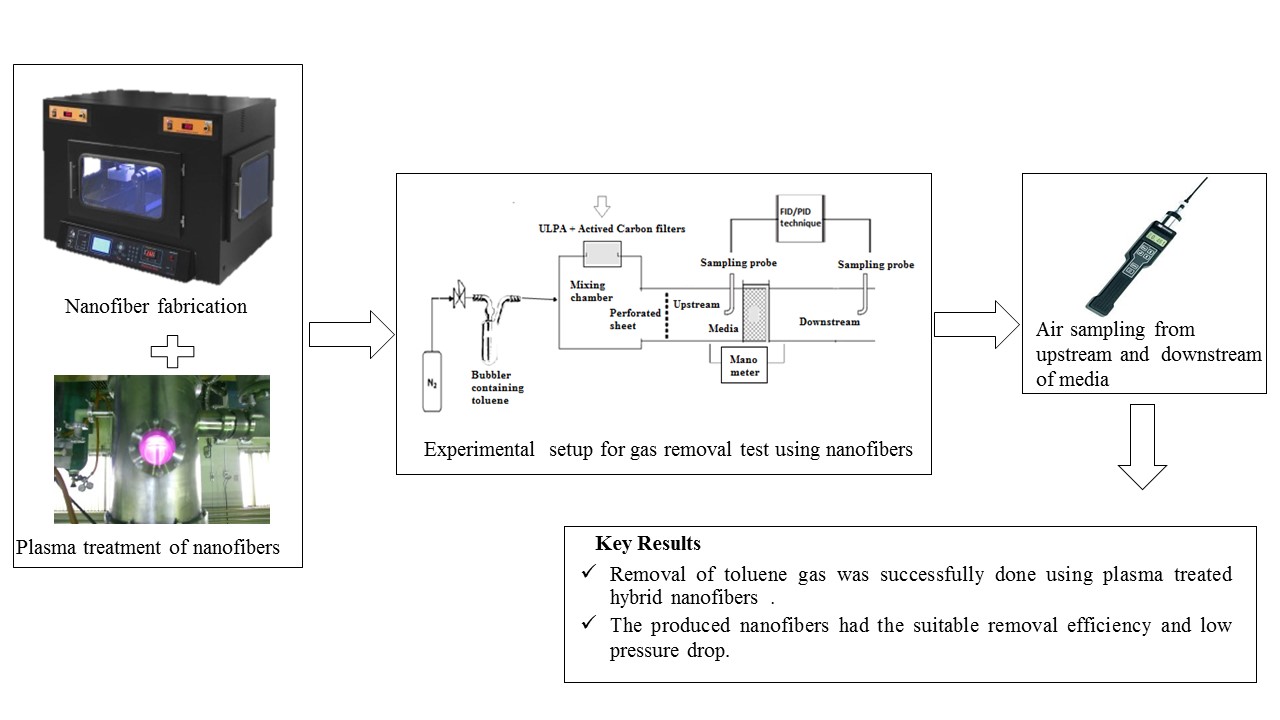Volume 9, Issue 3 (9-2019)
J Health Saf Work 2019, 9(3): 179-190 |
Back to browse issues page
Download citation:
BibTeX | RIS | EndNote | Medlars | ProCite | Reference Manager | RefWorks
Send citation to:



BibTeX | RIS | EndNote | Medlars | ProCite | Reference Manager | RefWorks
Send citation to:
Farhang Dehghan S, Golbabaei F, Sedigh Zadeh A, Mohammadi H. Possibility of using plasma-processed hybrid nanofibers to remove toluene in air stream. J Health Saf Work 2019; 9 (3) :179-190
URL: http://jhsw.tums.ac.ir/article-1-6164-en.html
URL: http://jhsw.tums.ac.ir/article-1-6164-en.html
1- Department of Occupational Health and Safety at Work, Workplace Health Promotion Research Center, School of Public Health and Safety, Shahid Beheshti University of Medical Sciences, Tehran, Iran
2- Department of Occupational Health, Tehran University of Medical Sciences, Tehran, Iran , fgolbabaei@ tums.ac.ir
3- Nuclear Fusion Research Center, Atomic Energy Organization, Tehran, Iran
4- School of Public Health, Tehran University of Medical Sciences, Tehran, Iran
2- Department of Occupational Health, Tehran University of Medical Sciences, Tehran, Iran , fgolbabaei@ tums.ac.ir
3- Nuclear Fusion Research Center, Atomic Energy Organization, Tehran, Iran
4- School of Public Health, Tehran University of Medical Sciences, Tehran, Iran
Abstract: (3858 Views)
Introduction: Despite nanofibers have attracted great interests for filtering particulate matters from the air stream, fewer studies have been done on the feasibility of their use in the removal of gas pollutants, while the both pollutants are present in the most workplaces. Toluene is a toxic and mutagenic substance, and chronic exposure to its low levels can lead to a wide range of adverse health effects on people who exposed. The purpose of this study was to produce polymer /single-walled carbon nanotube hybrid nanofibers by electrospinning technique and doing plasma surface treatment and evaluating their removal efficiency of toluene from air stream.
Material and Methods: The nanofiber layers were fabricated by electrospinning solution containing polyacrylonitrile polymer (PAN) and single-walled carbon nanotube (SWNT) with a 99: 1 ratio under following conditions: applied voltage 20 kV, distance between needle and collector: 10 cm, injection rate: 1 ml / h; needle diameter: 18 gauge and drum speed ranging from 1000 to 500 rpm. The surface of the manufactured nanofibers was treated by cold-plasma with a radio frequency power supply (13.56 MHz with a power of 20 watts), argon gas and operating pressure of 0.2 torr. Test conditions was prepared according to standard ISO 10121-1: 2014, which provides a method for testing the performance of gas-phase air filter for a variety of flat sheet media. In order to measure the concentration of toluene, the First check – handheld multi gas VOC detector equipped with a PID detector was used. The morphology characteristics of the fibers was performed using the analysis of scanning electron microscope images. Infrared spectroscopy-Fourier transform was used to identify organic compounds and functional groups in nanofibers.
Results: The results of the analysis of the images showed that the mean diameter of the fiber was 169.16 ± 7.19 nm and the mean coefficient of variation was 0.23. The uniform and bead nanofibers were obtained. The thickness, porosity and air permeability coefficient of test media was 0.15 mm, 43% and 5.75 Darcy, respectively. The mean removal efficiency of PAN / SWNT nanofiber treated with plasma was 98% and the mean pressure drop was 100 Pascal. The FTIR spectrum of the test filter media showed that the peaks appearing at certain wavelengths related to the vibration of C-H aliphatic groups of C-C and C=O bands related to PAN polymer and carbon nanotubes.
Conclusion: Removal of toluene was achieved through the fabrication of PAN/SWNT hybrid nanofibers treated with plasma. Uniform nanofibers were obtained and showed the proper removal efficiency and low pressure drop.
Material and Methods: The nanofiber layers were fabricated by electrospinning solution containing polyacrylonitrile polymer (PAN) and single-walled carbon nanotube (SWNT) with a 99: 1 ratio under following conditions: applied voltage 20 kV, distance between needle and collector: 10 cm, injection rate: 1 ml / h; needle diameter: 18 gauge and drum speed ranging from 1000 to 500 rpm. The surface of the manufactured nanofibers was treated by cold-plasma with a radio frequency power supply (13.56 MHz with a power of 20 watts), argon gas and operating pressure of 0.2 torr. Test conditions was prepared according to standard ISO 10121-1: 2014, which provides a method for testing the performance of gas-phase air filter for a variety of flat sheet media. In order to measure the concentration of toluene, the First check – handheld multi gas VOC detector equipped with a PID detector was used. The morphology characteristics of the fibers was performed using the analysis of scanning electron microscope images. Infrared spectroscopy-Fourier transform was used to identify organic compounds and functional groups in nanofibers.
Results: The results of the analysis of the images showed that the mean diameter of the fiber was 169.16 ± 7.19 nm and the mean coefficient of variation was 0.23. The uniform and bead nanofibers were obtained. The thickness, porosity and air permeability coefficient of test media was 0.15 mm, 43% and 5.75 Darcy, respectively. The mean removal efficiency of PAN / SWNT nanofiber treated with plasma was 98% and the mean pressure drop was 100 Pascal. The FTIR spectrum of the test filter media showed that the peaks appearing at certain wavelengths related to the vibration of C-H aliphatic groups of C-C and C=O bands related to PAN polymer and carbon nanotubes.
Conclusion: Removal of toluene was achieved through the fabrication of PAN/SWNT hybrid nanofibers treated with plasma. Uniform nanofibers were obtained and showed the proper removal efficiency and low pressure drop.
Type of Study: Research |
Received: 2019/10/1 | Accepted: 2019/10/1 | Published: 2019/10/1
Received: 2019/10/1 | Accepted: 2019/10/1 | Published: 2019/10/1
Send email to the article author
| Rights and permissions | |
 |
This work is licensed under a Creative Commons Attribution-NonCommercial 4.0 International License. |






